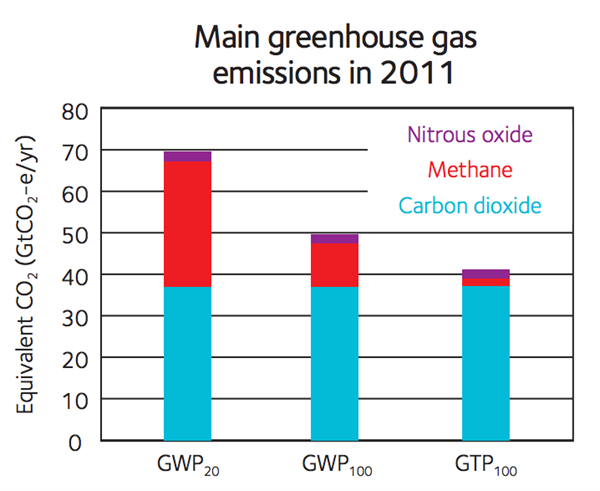
Cutting soot and methane distracts from 2C goal, says Oxford scientist
Sophie Yeo
05.28.15Sophie Yeo
28.05.2015 | 2:00pmPoliticians have agreed that global temperatures need to be limited to below 2C, and scientists say that this will mean drastically reducing emissions of greenhouse gases. But which one should be cut first?
Humans emitted 35.3 billion tonnes of carbon dioxide (CO2) in 2013 – a volume that is increasing every year, putting the world on course to exceed its goal to keep temperature increase since the start of the Industrial Age below 2C.
But this is not the only pollutant that causes the planet to warm. Methane, ozone, black carbon (soot) and hydrofluorocarbons have an even more powerful warming effect, per tonne, than CO2.
Yet unlike CO2, which can last in the atmosphere for up to millennia, these stick around in the atmosphere for a matter of years or even days. As a result, they are known as short-lived climate pollutants (SLCPs).
Most countries are focusing on reducing CO2 and SLCPs at the same time.
But a new policy paper by Myles Allen, professor of geosystem science at the Oxford Martin School at the University of Oxford, says that reducing SLCPs while CO2 emissions are still rising could make it more difficult to hit the 2C goal.
He argues that, while there are good reasons to cut SLCPs, they should not be used as an excuse to put off cutting CO2 emissions.
The problem
Governments are currently submitting pledges to the UN about how much they intend to reduce their greenhouse gas emissions.
The EU, for instance, has said it will cut its emissions by at least 40% by 2030 on 1990 levels. There is no obligation for countries to say how much of their reductions will come from CO2 cuts, and how much from SLCPs.
Instead, countries group them together, meaning that their emissions reductions targets can be hit by cutting any combination of any gases.
To create a level playing field between the different pollutants, they are measured according to how much global warming they will cause over a 100-year period.
For instance, over a 100-year period, one tonne of methane traps 28 times as much heat as one tonne of CO2. Black carbon traps 924 times as much.
But the lifespan of these pollutants is short, so most of this heat is trapped in the early years after they are emitted.
As a result, today’s emissions of methane and soot will have very little impact on global temperatures in 100 years’ time, as the graph below shows. GWP100 measures total heat trapped by 2011 emissions over the next 100 years, while GTP100 shows their impact on temperatures in 100 years’ time.
Each tonne of CO2, however, will still be lingering in the air, trapping as much heat then as it is today, as the graph below shows.
The first two bars show the impact of pollutants over a 20- and 100-year period. The third bar shows what impact they will be having in one hundred years from when they were emitted. Source: Short-Lived Promise? The science and policy of cumulative and short-lived climate pollutants
Timescales
The timescale of the climate change challenge matters.
As the above graph indicates, the majority of the warming impact of methane emissions will take place over the first 20 years after they were emitted. It’s a similar story for other SLCPs.
If politicians were trying to hit the 2C goal within the next 20 years, cutting methane emissions to zero would be a priority.
In reality, tackling climate change is likely to be a long-term challenge. The current draft of the UN deal set to be signed in Paris indicates that politicians are unlikely to cut emissions to zero before the second half of the century.
This means that politicians need to be looking at the long-term impact of their emissions. Cutting today’s SLCPs may prevent temperature rise in the short term, but their impact in one hundred years’ time will be negligible.
On the other hand, today’s CO2 emissions will still be pushing temperatures up as much in 100 year’s time as they are now.
Therefore, if it is the temperature at the end of the century and beyond that needs to be kept below 2C – and it is – then politicians need to be targeting CO2 emissions reductions now, rather than the quick fix of SLCPs.
Competition
The paper does not say that governments should not also be focusing on cutting SLCPs, but rather highlights that this should be seen as an end in itself, rather than as part of the international effort to limit global temperature rise.
There are also humanitarian reasons for tackling these emissions. The United Nations Environment Program says that tackling black carbon, for instance, could avoid 2.4 million premature deaths a year.
The two goals should not be confused, report author Myles Allen tells Carbon Brief:
“It’s about being clear what these different cuts can achieve, and keeping clarity that, unless we limit CO2 emissions, everything else is kind of moot as far as the long-term goal of avoiding dangerous climate change is concerned.”
SLCP reductions are, therefore, only a problem if countries start prioritising them over CO2 emissions.
There are several reasons why they may do so, the report says.
Reductions of pollutants such as black carbon and ozone would have immediate impacts on human health, making them more politically acceptable. Early reductions of SLCPs could also be cheaper and easier than CO2 cuts.
Policy
But is there any evidence that such a trade-off is happening in reality? Allen tells Carbon Brief:
“In Britain, the obvious one is fracking, where opponents of fracking point to fugitive methane emissions as possibly negating the climate benefits of switching to gas. Obviously, there’s lots to this, depending on what you’re switching from. Coal also produces methane. But the point is as long as CO2 emissions globally are still going up, the impact of these methane emissions on peak temperatures is negligible.”
In 2013, the US and China agreed to work together to reduce HFCs under the Montreal Protocol. But this was accused of being a distraction from the need to reduce CO2 emissions.
Allen adds that international actions to tackle climate change have overall been too weak for the issue of trade-offs to become a problem at a large scale.
Nonetheless, now is the time to tackle the issue, he says, with countries expected to scale up their actions at the end of this year following a UN deal on climate change.
One way to do this is to ensure that countries agree to a long-term goal for zero CO2 emissions.
There is currently a line in the draft of the Paris agreement which asks for “zero emissions of CO2 and other long-lived greenhouse gases in the period 2060-2080.” But this could disappear in favour of a target calling for a more broad-brush approach to greenhouse gases.
Allen tells Carbon Brief:
“If countries can get themselves to acknowledge that CO2 emissions have to get to zero, then that in effect overrules everything else. If you’re going to get CO2 emissions to zero on a timescale consistent with meeting the 2C goal, what you do about other gases is just additional to that.”
Short-term impacts
However, the impacts of short-term warming can also be problematic, Durwood Zaelke, president of the Institute of Governance and Sustainable Development, tells Carbon Brief:
“The paper acknowledges the importance of SLCPs for reducing near-term warming over the next 40 years. This is a critical period. If we lose the near-term climate battle, more of our governance resources will be diverted to disaster relief and adaptation. If one is worried about limited governance resources for climate change, this seems like the more appropriate one to worry about.”
Keeping warming down in the short term could also help to avoid irreversible tipping points that could be triggered in places such as the Arctic, affecting the planet for millennia to come.
And, as the paper itself argues, reducing SLCPs now means that climate change will take place more slowly and gradually, giving humans and ecosystems a greater chance to adapt.
Reducing SLCPs and carbon emissions are both important tasks, argues the paper – but they are the means to different ends. For humanitarian and political reasons, SLCPs should be reduced now. But for those focused on long-term climate change, the emphasis needs to remain on CO2.


